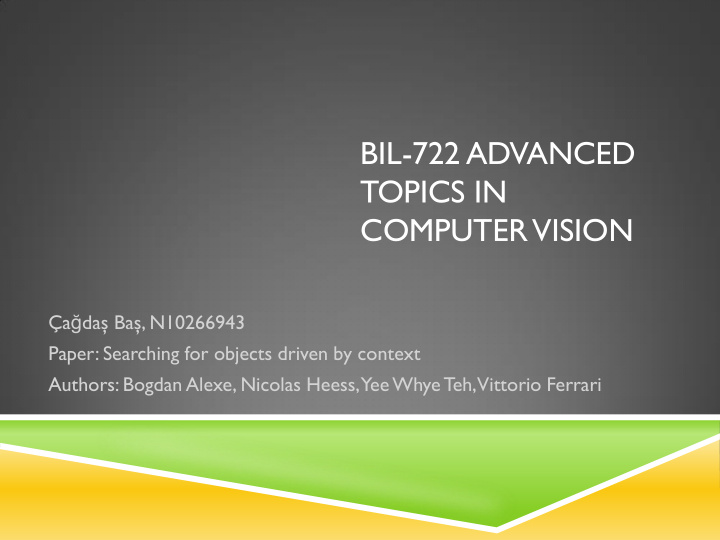



BIL-722 ADVANCED TOPICS IN COMPUTER VISION Ça ğ daş Baş , N10266943 Paper: Searching for objects driven by context Authors: Bogdan Alexe, Nicolas Heess, Yee Whye Teh, Vittorio Ferrari
PURPOSE: OBJECT DETECTION Among many problems, all the methods exhaustively search the object with help of the sliding windows approach. All the methods evaluates all the possible windows. This process is very slow and also unnatural. Cognitive search shows that humans don’t do that. Instead search intelligently.
PROPOSITION: INTELLIGENT SEARCH Learn an object’s relative position to its surroundings. An ideal search strategy would be like this: W 1 is sky, cars occur below sky so 1. look below. W 2 is road, cars occur on the road, 2. look just below the road There is a car part inside W 3 , look 3. surrounding patches. W 4 is a car. 4. Figure Credit: Alexe Bogdan
OVERVIEW OF THE METHOD Figure Credit: Alexe Bogdan
ALGORITHM IN A NUTSHELL Method randomly picks one window at the beginning. 1. Search Policy 𝜌 𝑇 : 2. Similar position/appearance duo searched in the training set. 1. Each of these similar patches votes for a new position. 2. Method accumulates these votes as probability maps and decides where to look 3. next. Output Policy 𝜌 𝑃 : 3. If current window similar enough to a car, search is over. 1.
ALGORITHM IN DETAIL: FEATURE VECTOR A window is represented by these vector: 𝑥 𝑚 = 𝑦 𝑚 , 𝑧 𝑚 , 𝑡 𝑚 , 𝑧 𝑢 Position Feature vectors Scale Window features 𝑧 𝑢 consists of: Normalized location and scale of the window HOG Histogram of the window Classifier score Displacement vector: Intersection over union with the ground truth box Normalized Hamming distance to the ground truth box Absolute difference in the window classifier with the ground truth box
ALGORITHM IN DETAIL: SEARCH POLICY Extract uniformly distributed windows from all the training images, store features. For a test image: Select a window, find it’s K -NN from training windows. 1. Map new window and acquire the new probability map. 2. Choose next window with the highest probability: 3.
ALGORITHM IN DETAIL: SEARCH POLICY (2) Calculate probability map with the new window in test image 𝑥 𝑢 Feature similarity kernel Spatial Smoothing Kernel 𝑥 𝑢 : Current window in test image. 𝑥 𝑚 : Window from training set.
ALGORITHM IN DETAIL: SEARCH POLICY (3) Normalize each probability map and integrate all the past maps. Feature similarity kernel Spatial Smoothing Kernel Integrate all maps to form the overall probability map using exponentially decaying mixture.
ALGORITHM IN DETAIL: OUTPUT POLICY After 𝑈 iteration, output a single window which has highest classification score amongst all: 𝑥 𝑝𝑣𝑢 = 𝑏𝑠max 𝑑(𝑥 𝑢 ) 𝑢 This is a downside. Method assumes that there is only one instance in the image.
ALGORITHM IN DETAIL: LEARNING WEIGHTS There is a weight for each class in similarity kernel stage. This weights defines each patch’s importance for each object class.
OBJECT CLASSIFIER An object classifier is trained for each class. For each class, one root HOG filter and several part HOG filters are trained. Root and part filters summed with weights according to Felzenswab’s work. For each class, training split is used for classifier learning.
EXPERIMENTS Experiments conducted on PASCAL VOC 2010 dataset. A highly challenging dataset which contains 20 object classes witch bounding box annotations. Validation set is used for testing. Mean Average Precision over all classes and detection rate and number of windows evaluated by the detector used as performance measures.
EXPERIMENTS: QUANTITATIVE
EXPERIMENTS: QUALITATIVE
EXPERIMENTS: QUALITATIVE Comparison of ? With Felzenszwalb et al. PAMI 2010
EXPERIMENTS: PERFORMANCE Experiments run on a Intel i7 processor powered PC. It can be seen that compared window count is significantly lower than the usual deformable part model approach. It is said that deformable part model approach takes 92s while proposed method takes only 2s.
PROS - CONS Pros: Fast and logical search Can be applied with any classifier/feature Cons: Assumes only one instance exists. Dataset dependent?
THANKS
Recommend
More recommend